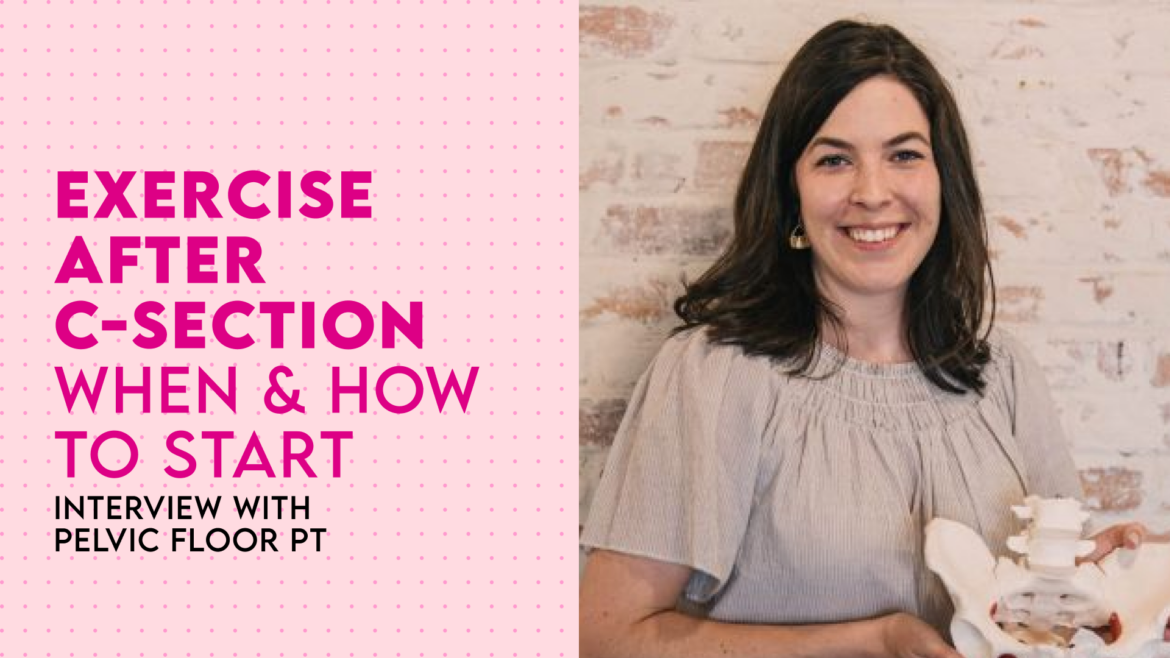You grew a baby for nine months. And then you had major abdominal surgery when you had the baby. Naturally, it’s going to take a good amount of time to recover and physically heal. When it comes to working out, how soon after a C-section can you exercise? When is it safe?
We spoke with Dr. Becky Allen, PT, DPT, founder and CEO of Genesis PT & Wellness, to get her top tips for safely returning to exercise after a C-section.
Common Exercise Questions After C-Section
Q: When is it safe to start exercising after a cesarean delivery?
Dr. Becky: Like anything, it depends. Each person is different. In a best-case scenario, most people need at least 6 weeks of downtime before easing back into exercise. Speak with your provider about your specific healing timeline, and wait for any pain, swelling, or bleeding to cease.
During those first couple of weeks postpartum, keep your activity level low. Focus on letting your body heal – including the incision and stitches. Focus on breastfeeding if you’ve chosen to do that, and ask your partner, family, and others for help lifting the baby, etc.
Q: Is there a timeline or milestones I should hit as I ease back into exercise?
Dr. Becky: Exercise after c-section delivery usually needs to wait a bit longer than after a vaginal delivery. This can be tough, especially if you were active before the birth. But it’s so important to let your body – including the stitches and incision – heal. However, this doesn’t mean you can’t do anything.
C-Section Recovery Week by Week
Dr. Becky shared a general timeline for c-section moms to follow as they reincorporate exercise postpartum:
Weeks 0 – 2
The only “exercise” I recommend during those first two weeks after birth is breathing. After months of pregnancy, you should focus on proper breathing to help reorient your core and diaphragm to function optimally. Your body is ready to learn. Not only can you practice breathing right away (yes, as soon as Day 1!), it’s good for your nervous system, your bowels and your bladder.
- Breathing Exercises
C-section moms should focus particularly on ribcage expansion at first. Imagine an umbrella opening. Inhale slowly through your nose, then exhale out the mouth as though you’re trying to fog up a mirror. This helps with reflexive abdominal coordination. You can practice breathing in any position, and at any time.
Weeks 2 – 4
During the next couple of weeks, you start feeling better and can move a bit more comfortably. Your core and pelvic floor muscle connection is the next necessary step.
- Continue Incorporating Breathing Exercises
Again, use your breath to find this connection. Practice this more advanced core breathing exercise: Breathe in slowly through your nose, and as you exhale from your mouth draw your hipbones together gently, or imagine you’re pulling your pelvic floor up toward the crown of your head. This can be done in all positions – sitting, standing, or lying on your side. - Stomach Stretch
“Mommy tummy time” can be worked into your daily routine! You’re probably ready to start putting more pressure on your core and abdominal wall. Lay on your tummy, stretching your body, and inhale, allowing your core muscles to turn off. Exhale, engaging your core. - Reintroduce Walking
You can also start reintroducing walking, assuming your stitches have dissolved and you’re no longer bleeding. Begin with five to 10 minute increments. Your body is still in the healing stage, so don’t exert more than 10 – 15 percent of your max effort. - Lift Light Objects
You can start lifting things that are the weight of your baby. Remember to inhale through your nose as you reach down, and exhale through your mouth as you lift.
Weeks 4 – 6
By now your incision should be healed and most likely you’re no longer swelling or bleeding. You’re probably antsy to start moving more.
- Begin Incorporating Squats, Hinges, or Deadbug Exercises
If you were active during pregnancy, you can slowly add functional movements into your routine. Do similar movements as you did during pregnancy such as squats, hinges, or deadbugs.
Squats
Hinges
Modified Deadbugs
- Stick with Low-Impact Movement (i.e. walking)
If you were less active during your pregnancy (i.e. you didn’t have a regular exercise routine), stick to low-impact walking, and similar movements that you did while pregnant. Your body is still healing, and it’s best to wait at least 6-8 weeks post-c-section delivery before doing more. - Begin the Core Basics Program
This is a great time to check out Get Mom Strong’s Core Basics program. This foundational program will help you to reconnect your deep core and pelvic floor.
Weeks 6 – 8
Around this point, you should see your provider, and hopefully get the green light to resume activity.
- Increase Workout Intensity/Duration
You can increase the time and intensity of workouts but listen carefully to your body. It’s not yet time to do high impact exercise. You don’t want to overdo it and set your recovery back.
- Begin Adding Low Weights
Stick to gentle exercises. Start adding low weights into your workouts.
Weeks 12 and Beyond
Your energy levels are rising, your c-section scar is healed. You can begin to “increase to impact.” This means you can run, jump, and lift heavier weights. Always, always, always listen to your body.
- Work with a PT
If you’re particularly active (for example, competing in athletics), please work with a pelvic floor physical therapist.
Q: Are there any important modifications specific to c-section moms?
Dr. Becky: Minimize lifting during those first couple of weeks. (Get help from your partner if you have one!) From weeks two to six, keep it light. Try not to lift anything heavier than your baby.
Over the following weeks, once you have the green light from your provider, you can start adding low weights into your workouts, slowly building back up to where you were pre-baby.
Q: What Exercises Should I Avoid After a C-Section?
Dr. Becky: While your body is in acute healing mode, avoid lifting and twisting movements. This optimizes healing and helps you avoid setbacks.
Q: While it’s not exercise, per se, the core and pelvic floor connection is critical. Do c-section moms need pelvic floor therapy?
Dr. Becky: I highly encourage new moms to see a pelvic floor physical therapist a couple of times after a c-section to evaluate your healing progress. Even though you didn’t give birth vaginally, pregnancy puts a lot of strain and pressure on the pelvic floor.
Ideally, a new c-section mom would come in at two, four, and six weeks postpartum, and more, if necessary, after that.
I recognize that not all people have access to a pelvic floor PT (or even know that they should see one). Resources like Get Mom Strong can help your recovery. And remember, it’s never too late to do pelvic floor work. Everyone can benefit, at any time.
About Dr. Becky
Dr. Becky (follow her @genesisptwellness) is one of our SLAM Stretch contributors. She created a safe space for women to receive high quality, specialized Pelvic Floor Therapy that is unique to their specific needs. She’s passionate about treating every person as a whole, not as just an injury, pain, or dysfunction. Becky utilizes a holistic approach to pelvic floor therapy, meeting you where you are now and walking alongside you on your new journey.

